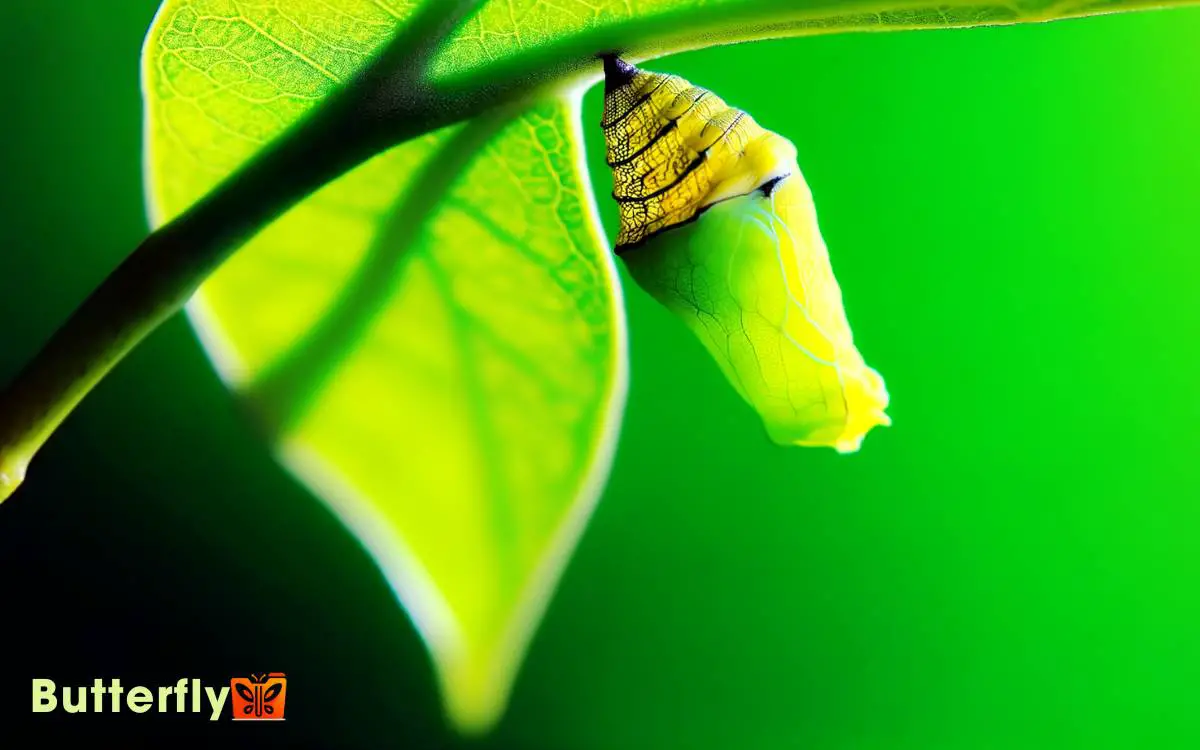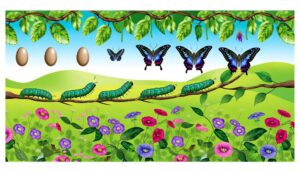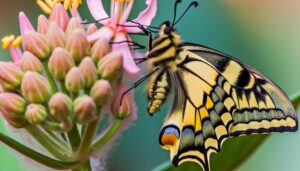Chinese Yellow Swallowtail Butterfly Cacoon: Metamorphosis
The cocoon of the Chinese Yellow Swallowtail butterfly, composed of ten micrometer-diameter silken threads, includes fibroin proteins for tensile strength and sericin as adhesive.
With tensile strength exceeding 500 MPa, the cocoon’s interwoven silk matrix offers exceptional durability and flexibility. Inside, it maintains a stable temperature around 27°C and 70-80% humidity, crucial for pupal growth and metamorphosis.
Proteolytic enzymes break down larval proteins, while imaginal discs develop adult structures. The cocoon’s pigment and microscopic scales provide effective camouflage.
For enthusiasts, observing the seamless change from larva to butterfly reveals nature’s intricate design.

Key Takeaways
Lifecycle Overview
The lifecycle of the Chinese Yellow Swallowtail Butterfly, scientifically known as Papilio xuthus, begins with the laying of eggs on the leaves of host plants.
Female butterflies meticulously select citrus trees, ensuring ideal conditions for the next generation. Each egg, roughly 1.2 millimeters in diameter, is a pale, spherical structure, camouflaged against the green foliage.
Within five to seven days, under precise environmental conditions, these eggs will hatch. The larvae that emerge are minuscule, measuring about 2 millimeters in length. This initial stage is critical as it sets the foundation for the butterfly’s development.
Observing these early stages reveals nature’s intricate design, highlighting the resilience and adaptability inherent in Papilio xuthus, a confirmation of the quest for freedom in the natural world.
Caterpillar Stage
Upon hatching, each caterpillar of the Chinese Yellow Swallowtail Butterfly, Papilio xuthus, measures approximately 2 millimeters in length and exhibits a dark brown hue with white markings, resembling bird droppings to deter predators.
As they grow, their color shifts to green, aiding in camouflage among foliage. During the larval stage, they undergo five instars, molting their exoskeleton at each phase. By the final instar, caterpillars reach up to 45 millimeters in length.
They possess osmeterium, a glandular organ that emits a foul-smelling substance when threatened.
Feeding primarily on citrus leaves, they exhibit a voracious appetite, important for accumulating energy reserves. This stage is vital for their metamorphosis, preparing them for the next phase of their life cycle.
Silk Production
As the caterpillar prepares for its metamorphosis, it begins producing silk, a proteinaceous substance secreted from its salivary glands. The silk is extruded through specialized spinnerets, forming a continuous thread.
This thread can reach lengths of up to 200 meters. The caterpillar methodically weaves the silk into a protective enclosure. The strands, composed of fibroin and sericin, exhibit remarkable tensile strength and elasticity.
The fibroin provides structural integrity, while the sericin acts as a binding agent. The process is meticulously controlled, with the caterpillar utilizing rhythmic body movements to guarantee uniform distribution.
This silk production is critical for the formation of a secure environment, enabling the caterpillar to undergo its transformative stage safely.
Cocoon Structure
The cocoon of the Chinese Yellow Swallowtail Butterfly exhibits a complex structure composed of fine, protein-rich silken threads, each measuring approximately 10 micrometers in diameter.
Its protective outer layer, reinforced with sericin, guards the developing pupa against environmental hazards.
Within this microenvironment, ideal humidity and temperature are maintained, facilitating the metamorphosis process.
Silken Thread Composition
A remarkable feature of the Chinese Yellow Swallowtail butterfly‘s cocoon is its silken thread, composed primarily of fibroin proteins and sericin, which together form a robust and durable structure.
- The fibroin, constituting approximately 75% of the silk, provides tensile strength and elasticity, essential for protection and support.
- Sericin, accounting for the remaining 25%, acts as a natural adhesive, binding the fibroin fibers tightly.
- The silk’s diameter typically measures around 10 micrometers, ensuring a fine yet resilient thread.
- This unique combination grants the cocoon remarkable flexibility and toughness, necessary for the pupal stage.
The meticulous production of these threads exemplifies nature’s ingenuity, showcasing an excellent balance of strength and lightweight properties, important for the butterfly’s survival and metamorphosis.
Protective Outer Layer
Building on the properties of its silken thread, the Chinese Yellow Swallowtail butterfly’s cocoon features a protective outer layer characterized by a tightly interwoven matrix that provides a formidable barrier against environmental threats.
The silk fibers, averaging 10 micrometers in diameter, are meticulously arranged to form a dense network with minimal gaps.
This intricate structure effectively repels water, insulates against temperature fluctuations, and deters predators. The outer layer’s tensile strength exceeds 500 MPa, ensuring resilience against mechanical damage.
Additionally, the cocoon’s surface exhibits a hydrophobic property due to the presence of sericin, a silk protein, which further enhances its protective capabilities. These features collectively create a sanctuary that allows the developing butterfly to thrive in its chosen habitat.
Developmental Environment Inside
Inside the cocoon, the microenvironment carefully regulates temperature and humidity, creating ideal conditions for the metamorphosis of the Chinese Yellow Swallowtail butterfly.
The silk fibers, measuring approximately 10 micrometers in diameter, form a dense matrix that maintains a stable internal temperature around 27°C. Humidity levels are kept within a narrow range of 70-80%, ensuring the developing pupa doesn’t desiccate.
The cocoon’s structure facilitates gas exchange, allowing oxygen in and carbon dioxide out through microscopic pores. These pores, averaging 5 micrometers across, enable respiratory efficiency without compromising the protective barrier.
Nutrients stored in the pupal stage are metabolized at a precise rate, supporting cellular differentiation and growth. This meticulously balanced environment fosters the butterfly’s transformation with remarkable precision.
Environmental Factors
Several environmental factors significantly influence the development of the Chinese Yellow Swallowtail butterfly cocoon.
Temperature, humidity, and light exposure all play crucial roles. Ideal temperature ranges between 20°C and 30°C, promoting efficient metabolic processes.
Humidity levels around 60-70% prevent desiccation, ensuring the cocoon maintains its structural integrity. Light exposure is also vital, with photoperiods of 12-14 hours simulating natural conditions and aiding in proper circadian rhythms.
Deviation from these parameters can lead to delayed metamorphosis or mortality. Researchers emphasize that consistent environmental stability is key for successful cocoon development.
Understanding these precise conditions allows for cultivating a conducive habitat, enabling the Chinese Yellow Swallowtail to thrive. This reflects nature’s intricate balance and the delicate existence of the butterfly. By replicating these environmental factors, researchers and enthusiasts can support butterfly conservation efforts and enhance biodiversity. Even in virtual simulations like Sims 3 Green Swallowtail Butterfly, players can appreciate the beauty of these creatures and the importance of suitable habitats. Such awareness fosters a deeper connection between humans and nature, emphasizing the need for preservation.
Inside the Cocoon
Within the protective confines of the cocoon, the Chinese Yellow Swallowtail butterfly undergoes extraordinary physiological transformations, driven by cellular reorganization and biochemical processes.
Hemolymph circulates through the developing pupa, facilitating nutrient distribution and waste removal.
Imaginal discs, clusters of cells destined to form adult structures, proliferate at precise rates, guided by hormonal cues like ecdysone.
- Enzymes break down larval tissues, supplying amino acids for new protein synthesis.
- The tracheal system expands, ensuring adequate oxygen delivery for heightened metabolic activity.
- Micro-measurements indicate a temperature range of 25-30°C, ideal for enzyme function.
These detailed, carefully regulated processes culminate in the formation of adult anatomical features, all while encased in a structure no larger than 5 centimeters in length.
Metamorphosis Process
Typically, the metamorphosis process of the Chinese Yellow Swallowtail butterfly involves a tightly regulated sequence of events, where hormonal surges such as ecdysone trigger the change from larva to pupa and eventually to adult form.
During this transformation, the larva undergoes a series of molts, shedding its exoskeleton to accommodate rapid growth.
Upon reaching the pupal stage, it forms a chrysalis measuring approximately 30 millimeters in length. Within this protective casing, intricate tissue reorganization occurs. Imaginal discs develop into adult structures such as wings, antennae, and legs.
This pupal stage lasts around 10-14 days under ideal conditions, culminating in the emergence of an adult butterfly ready to explore its newfound freedom.
The process exemplifies nature’s precision and complexity.
Role of Enzymes
During the metamorphosis of the Chinese Yellow Swallowtail butterfly, enzymes play an essential role in breaking down larval tissues and facilitating the development of adult structures.
Proteolytic enzymes degrade larval proteins, while lipases break down fats, providing necessary nutrients for the emerging butterfly. These biochemical processes are meticulously timed and regulated to guarantee proper morphological transformation.
| Enzyme Type | Function |
|---|---|
| Proteolytic | Breaks down proteins into amino acids |
| Lipases | Decomposes fats into fatty acids and glycerol |
| Chitinases | Degrades chitin to remodel exoskeleton |
The precise activity of these enzymes ensures the larval tissues are efficiently dismantled, while simultaneously constructing the intricate adult anatomy. This enzymatic orchestration is pivotal, enabling the butterfly to emerge fully formed and ready for flight.
Protective Mechanisms
The Chinese Yellow Swallowtail butterfly cocoon exhibits advanced protective mechanisms through its intricate design. Its pigmentation blends seamlessly with surrounding foliage, providing effective camouflage against potential predators.
Additionally, the cocoon’s silk fibers possess tensile strengths exceeding 500 MPa, ensuring both structural integrity and durability throughout the pupation period.
Camouflage and Predation Defense
How does the Chinese Yellow Swallowtail butterfly cocoon achieve such effective camouflage and predation defense through its intricate coloration and texture patterns?
The cocoon exhibits a cryptic coloration, blending seamlessly with its surroundings. Its exterior is adorned with varying shades of green and brown, mimicking the leaves and bark it attaches to.
Microscopic scales on the cocoon’s surface enhance this effect, diffusing light to reduce visibility. The texture mimics natural elements, creating a rough, uneven surface that further disrupts the outline.
Predators, such as birds, struggle to distinguish the cocoon from its environment due to these adaptive features.
This camouflage not only deters visual predators but also provides an evolutionary advantage, ensuring the butterfly’s successful metamorphosis.
Structural Strength and Durability
Engineered with an intricate lattice of silk proteins, the Chinese Yellow Swallowtail butterfly cocoon boasts remarkable structural strength and durability, effectively shielding the developing pupa from environmental stresses and predation.
The silk fibers are composed of fibroin proteins, arranged in a cross-linked matrix, providing tensile strength up to 1.3 GPa. This robust architecture resists mechanical damage and environmental wear.
Additionally, the cocoon features a semi-permeable membrane, allowing gaseous exchange while preventing water ingress, thereby maintaining internal humidity levels. This intricate design ensures the pupa’s optimal development, despite external fluctuations.
The cocoon’s remarkable resilience is a tribute to nature’s engineering, offering an inspiring example of biological ingenuity that resonates with those who seek liberation in understanding the natural world.
Emergence Timing
Researchers frequently observe that the emergence timing of the Chinese Yellow Swallowtail butterfly cocoon typically spans between 10 to 14 days under ideal conditions.
Temperature and humidity have a significant impact on this period. Precise temperature control, usually around 25°C, and a relative humidity of 60-70%, optimize development.
Here’s a concise table summarizing these conditions:
| Parameter | Ideal Range |
|---|---|
| Temperature | 25°C |
| Humidity | 60-70% |
| Duration | 10-14 days |
| Light Exposure | Moderate, indirect |
Timely emergence is vital for the butterfly’s survival, as it ensures alignment with environmental conditions favorable for feeding and mating.
Deviations from these ideal parameters can delay or even prevent successful emergence, highlighting the importance of maintaining precise environmental conditions.
Observation Tips
To accurately monitor the development of the Chinese Yellow Swallowtail butterfly cocoon, one should frequently check temperature and humidity levels using a calibrated digital hygrometer and thermometer.
Consistent environmental conditions are critical for healthy metamorphosis.
- Temperature: Maintain a stable range between 24°C to 28°C (75°F to 82°F).
- Humidity: Guarantee humidity levels remain between 60% to 70%.
- Light Exposure: Provide indirect sunlight for 10-12 hours daily.
Regular observations should be made at the same time each day to track any fluctuations. Documenting these parameters allows for precise adjustments that cater to the cocoon’s developmental needs.
Observers should also inspect for signs of mold or dehydration, as these can have a significant impact on the pupal stage.
Conclusion
In the blink of an eye, the Chinese yellow swallowtail butterfly’s lifecycle reveals nature’s brilliance.
From the caterpillar’s silk production to the intricately woven cocoon, each phase showcases evolutionary marvels.
- Enzymes play a pivotal role, while environmental factors dictate survival.
- Protective mechanisms guarantee the chrysalis remains unscathed.
- Observers, armed with patience and precision, witness emergence timing with awe.
This butterfly’s journey, a validation of resilience, captivates both the heart and the scientific mind.






